BIOL 1030 / Topic 11: Plant Nutrition
1/67
There's no tags or description
Looks like no tags are added yet.
Name | Mastery | Learn | Test | Matching | Spaced |
|---|
No study sessions yet.
68 Terms
What are the requirements of photosynthesis?
CO2 and H2O.
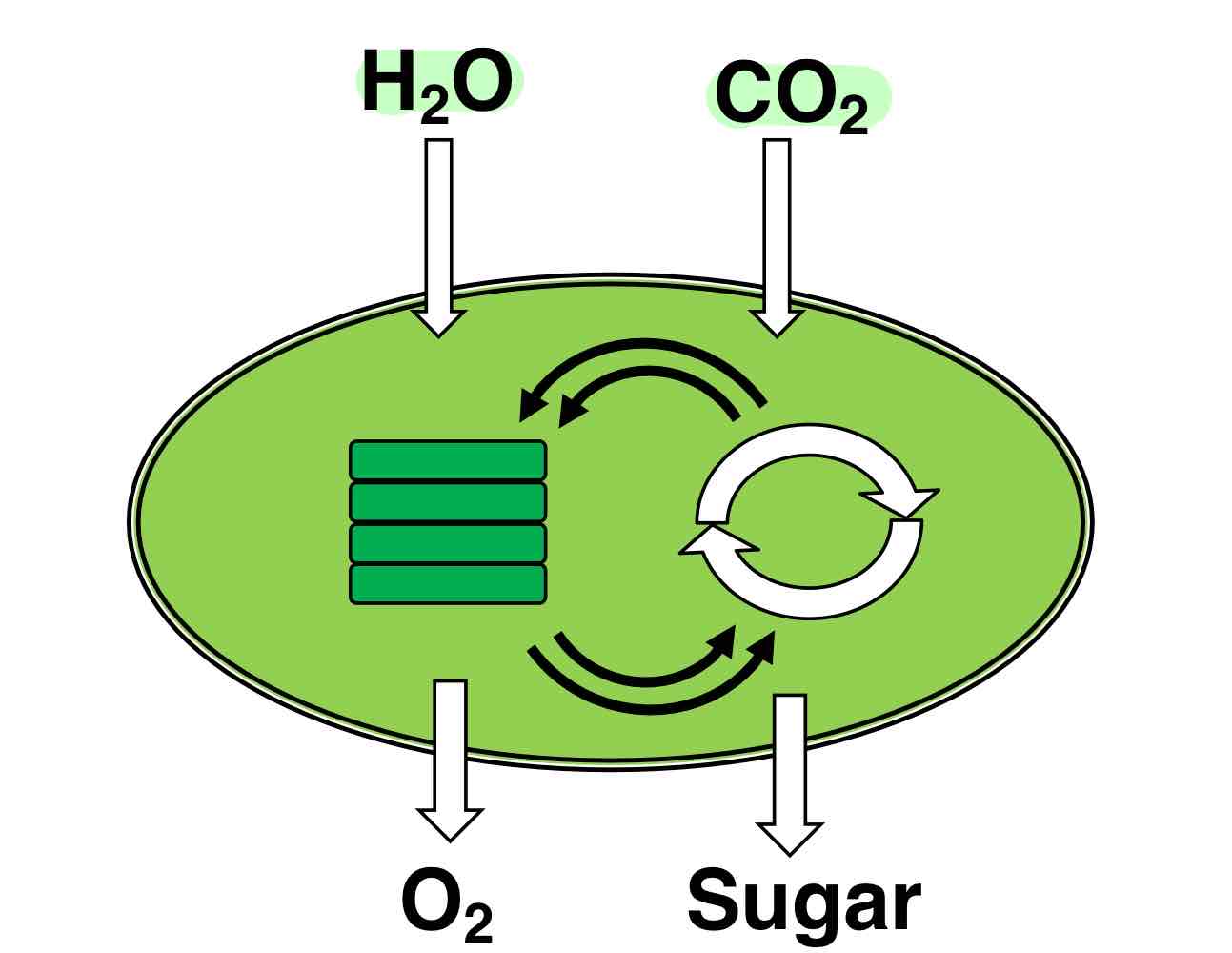
What are the products of photosynthesis?
Glucose and O2.
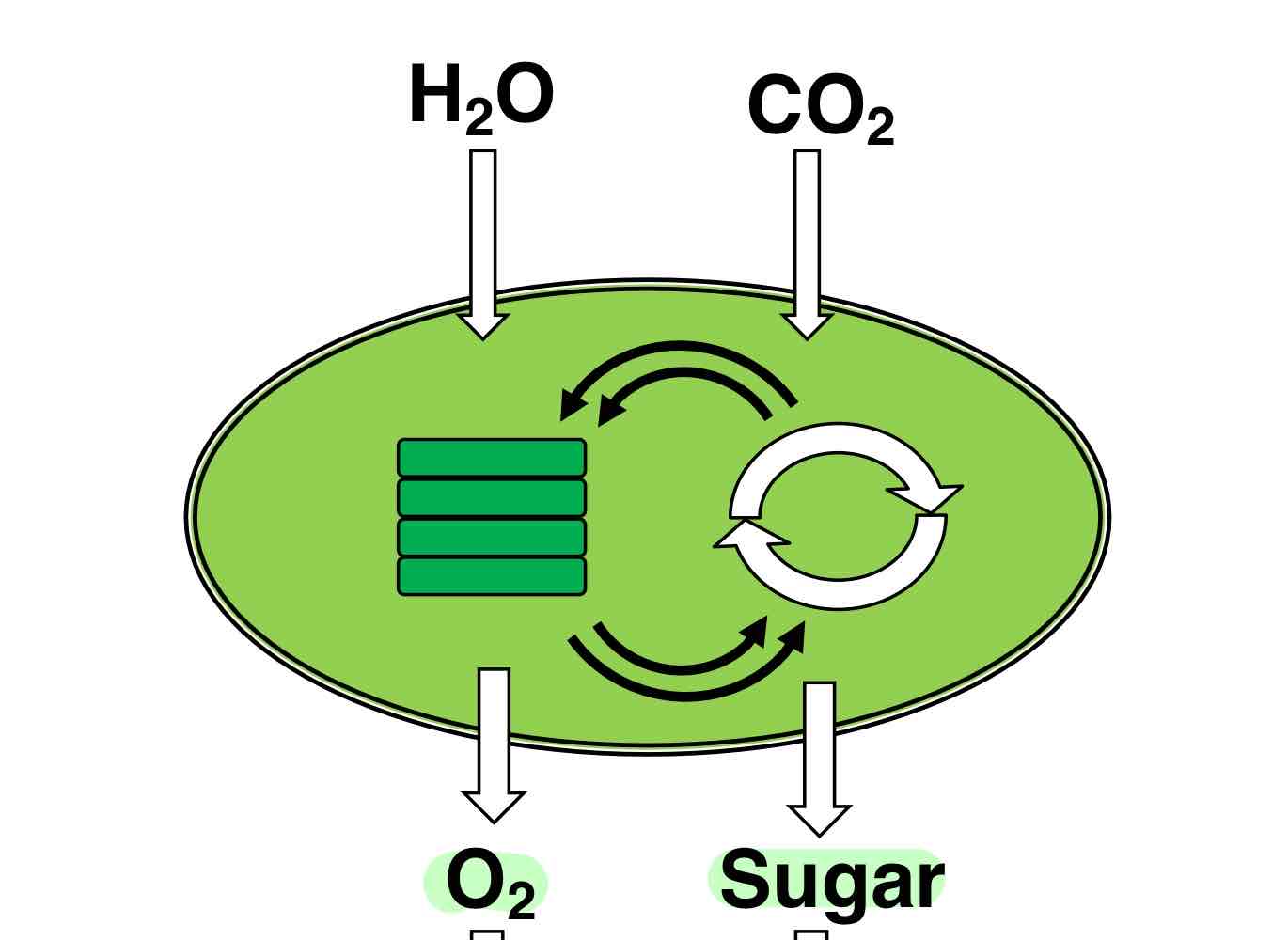
Why do plants need glucose, a product that can also be a requirement for them? Where does glucose go to after being produced?
Nutrition. It goes to the phloem.
Why do plants need O2, a product that can also be a requirement for them?
Cellular respiration to make energy.
What reactants do cells need? Tell me where each comes from.
CO2, from atmosphere.
Minerals, from soil.
O2, from soil and cells.
H2O, from soil.
Glucose, from leaves.
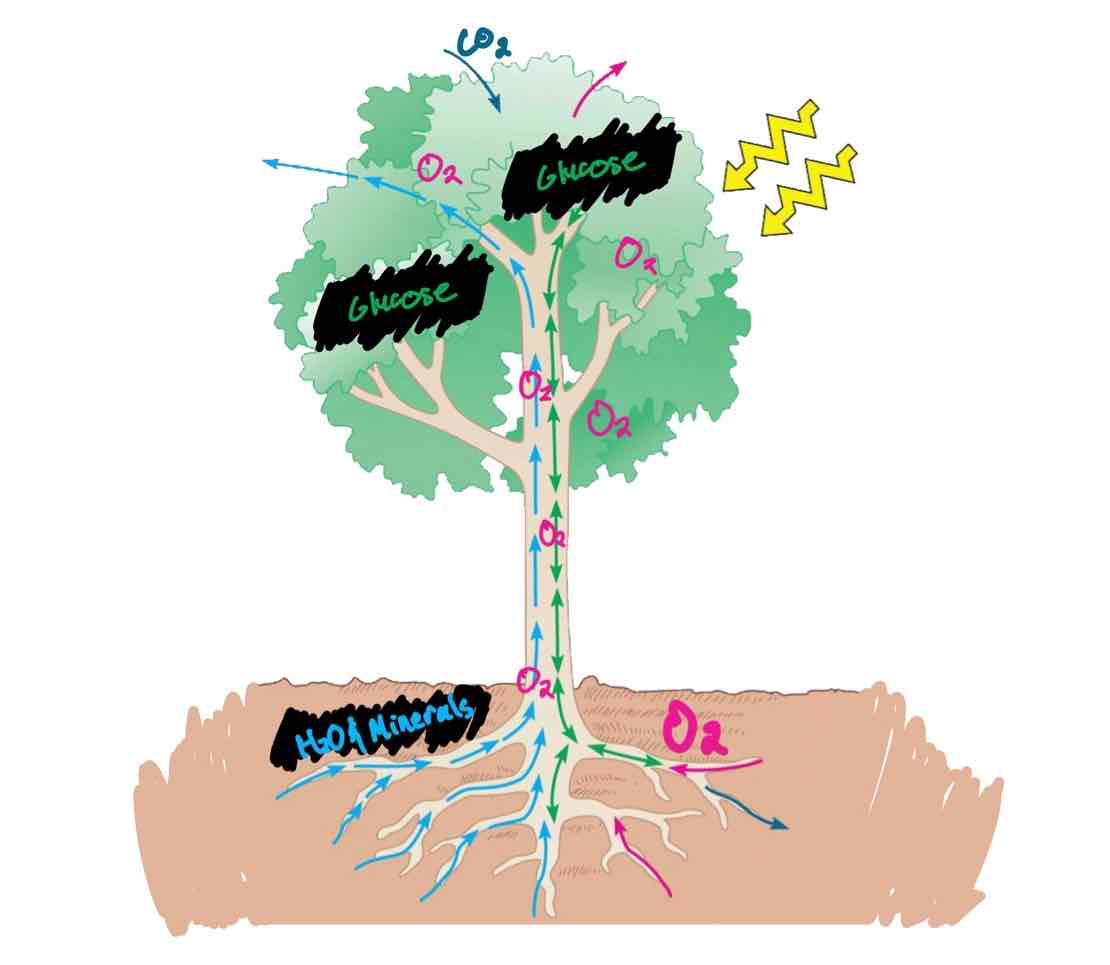
Plants need a waste removal system in order to remove _____ from their system.
Plants need a waste removal system in order to remove oxygen from their system.
Explain why nitrogenous wastes are not needed to be removed from plants.
Nitrogen can be useful to plants for growth and different processes.
What’s the difference between short distance transport and long distance transport?
Short distance transport is between cells, while long distance transport is from root to shoot.
What is the apoplast?
The plant tissue compartment consisting of everything external to the plasma membrane, including cell walls, extracellular spaces, and interior of dead cells.
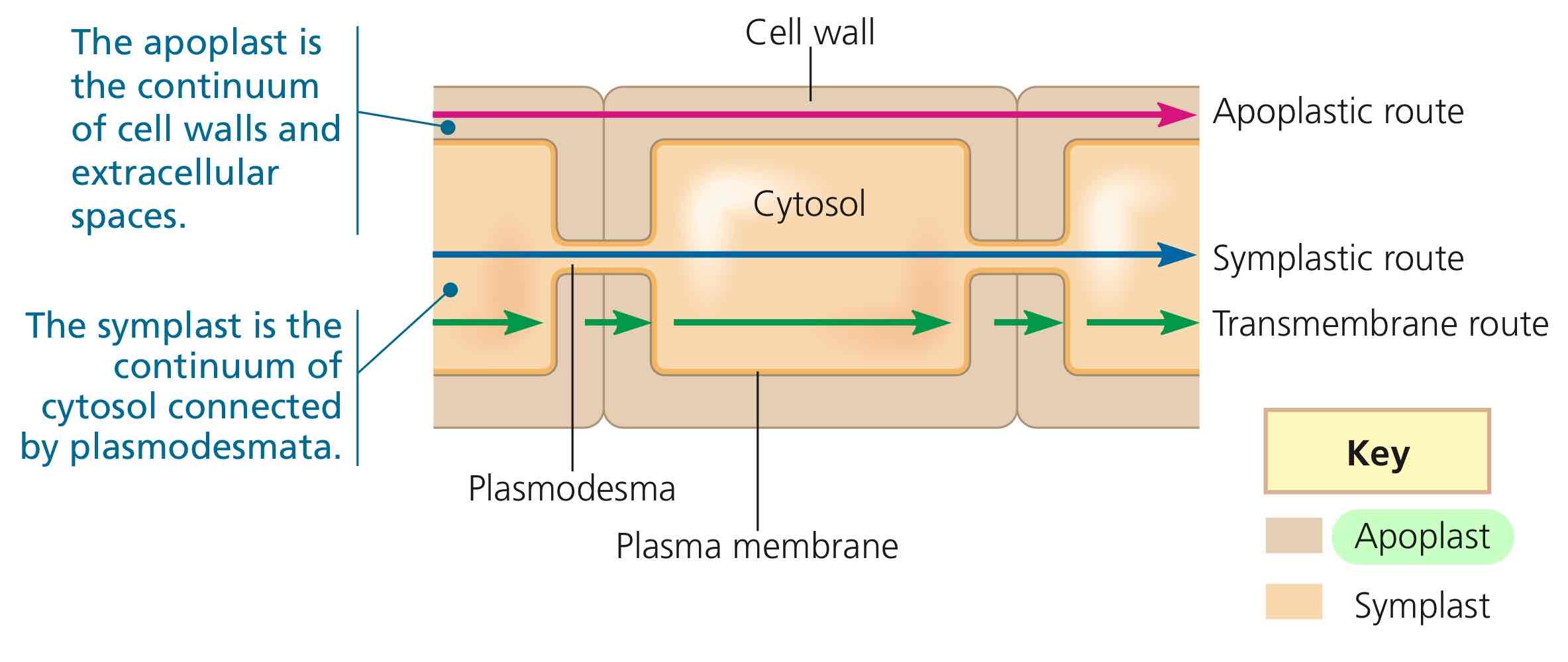
What is the symplast?
The plant tissue compartment consisting of entire mass of cytosol of all the living cells in a plant, including the plasmodesmata.

What are the three different transport routes for water and solutes in plant cells?
Symplast, apoplast, and transmembrane.
What’s the symplast route?
The route going straight through plasmodesmata.
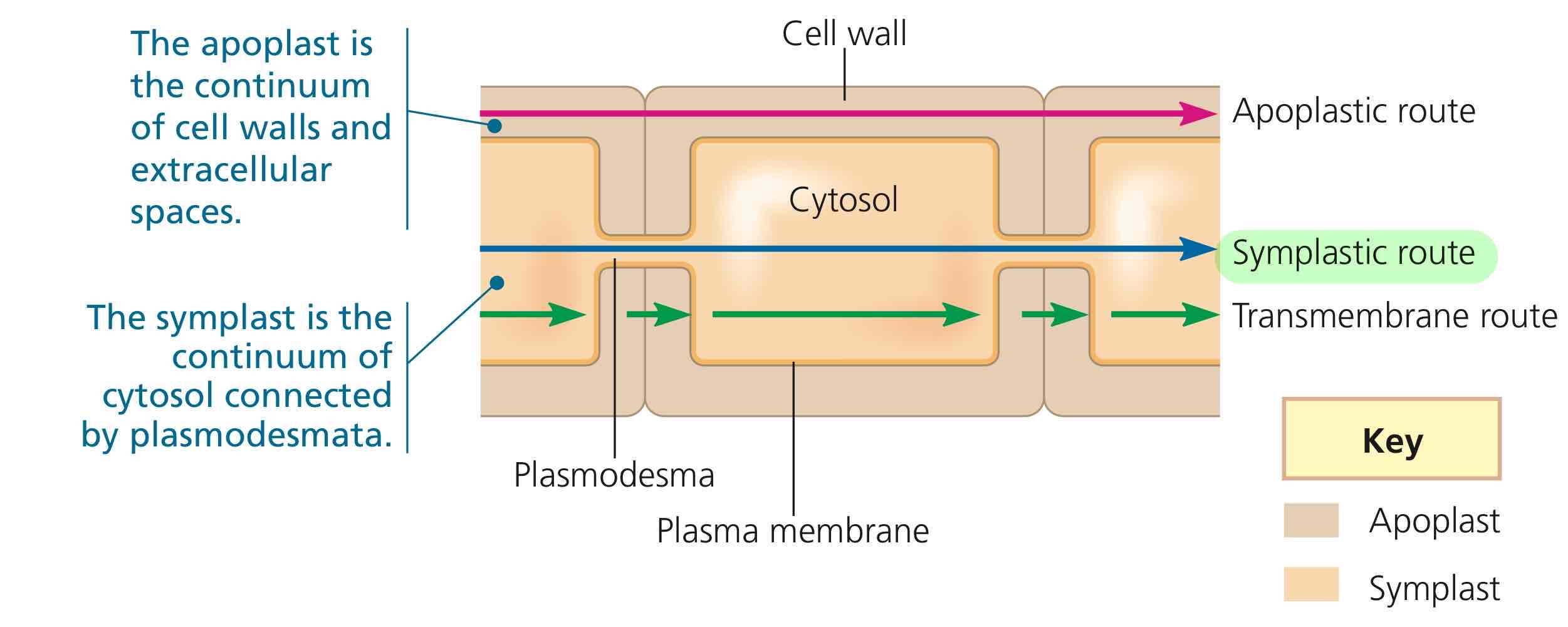
What’s the apoplast route?
The route going straight through the cell wall.

What’s the transmembrane route?
The route going through the symplast, then through the apoplast, then repeat.
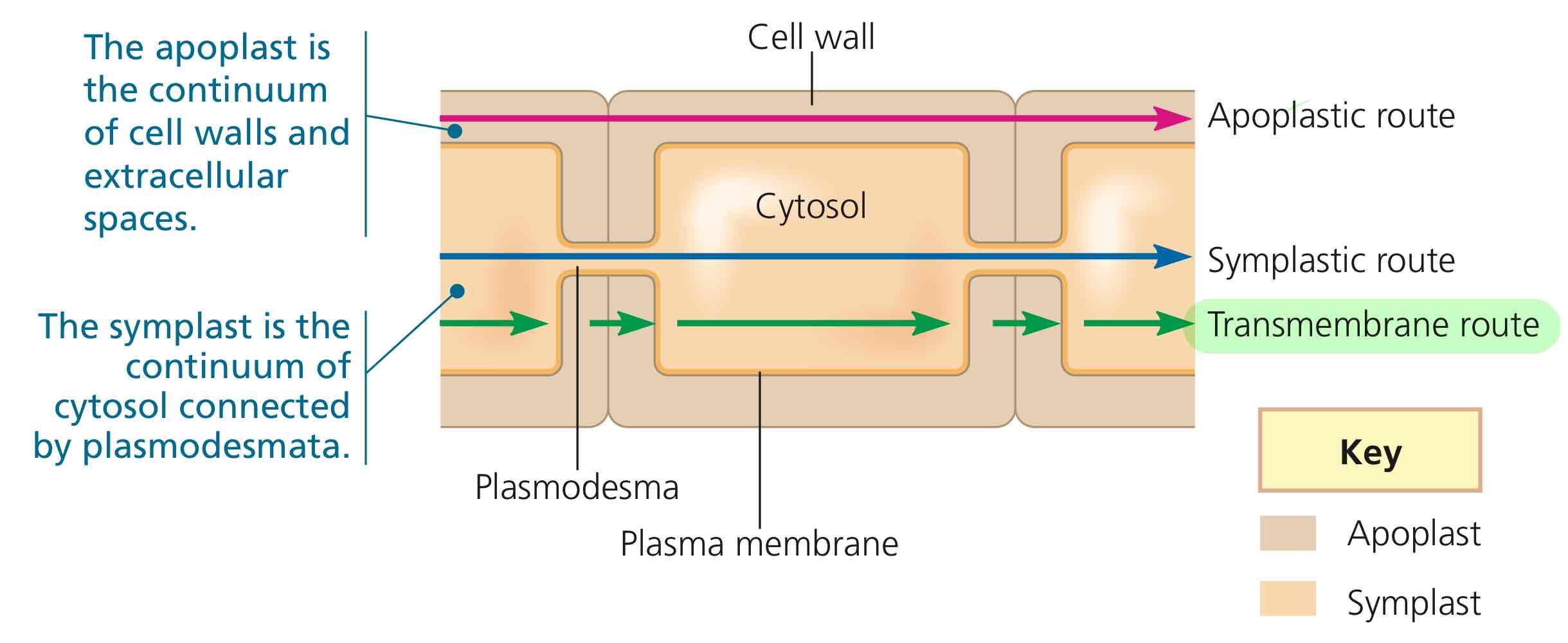
What specific part of the cell offers control for short distance transport?
The cell membrane.
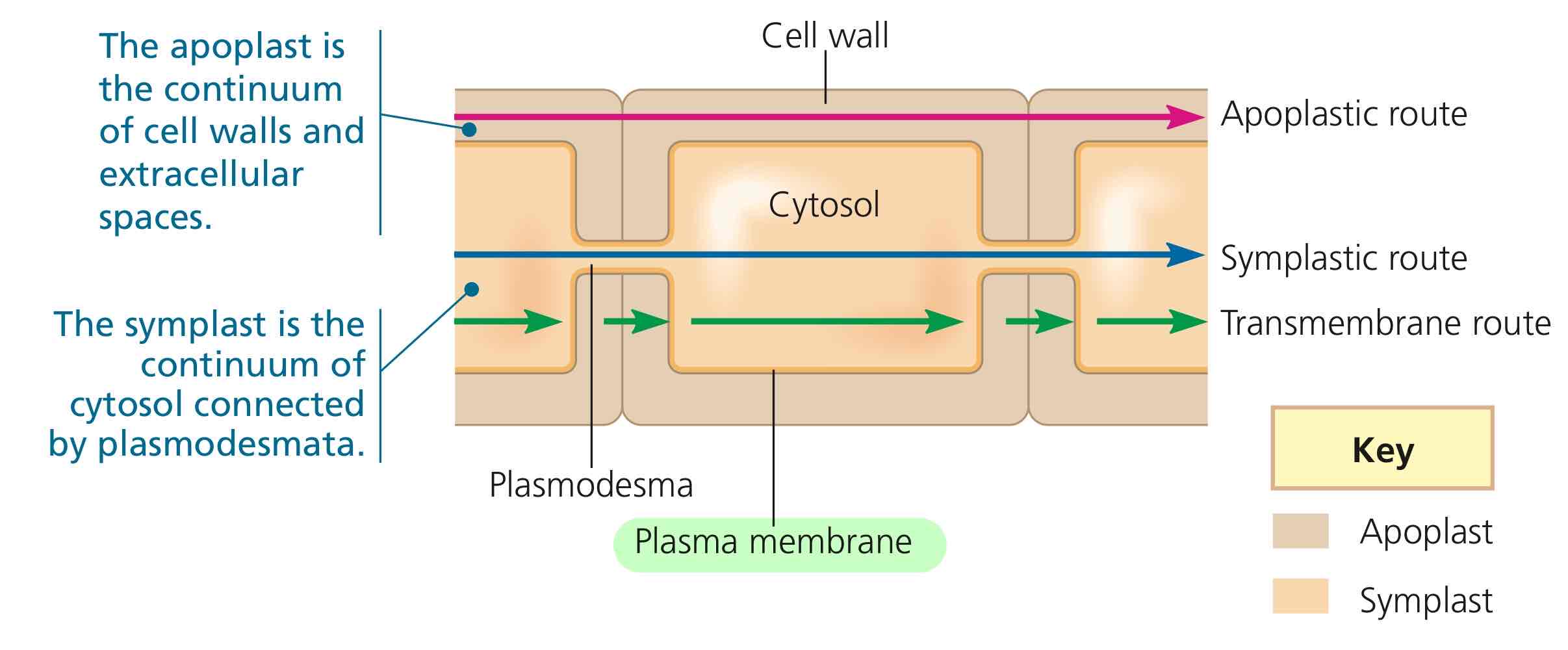
Rank the short distance transport routes from least control to most control. Explain briefly.
The apoplastic route does not offer any control because the water and solutes do not pass through any cell membrane.
The symplastic route offers some control because the water and solutes go through the cell membrane once, which is when they first enter the plant.
The transmembrane route offers most control because the water and solutes go through multiple cell membranes.
What are the three mechanisms of how solute transport can occur across membranes?
Primary active transport.
Secondary active transport.
Gated potassium channels.
What happens in the primary active transport (PAT)?
In PAT, we use ATP to activate the proton pump to pump protons from an area with [proton]low to area with [proton]high, with the areas being the cytoplasm and the extracellular environment, respectively.
![<p>In PAT, we use ATP to activate the proton pump to pump protons from an area with [proton]<sub>low</sub> to area with [proton]<sub>high</sub>, with the areas being the cytoplasm and the extracellular environment, respectively.</p>](https://knowt-user-attachments.s3.amazonaws.com/141552e1-9ce5-40cc-bc76-530b6e0554a9.jpg)
Why does PAT need to occur?
PAT needs to occur in order secondary active transport to occur.
What happens in secondary active transport (SAT)?
In SAT, we use the pumped protons from PAT and cotransport proteins to get impermeable solutes (e.g. sugars and nitrates) across the cell membrane, with the solutes ultimately ending up where they need to be thereafter.
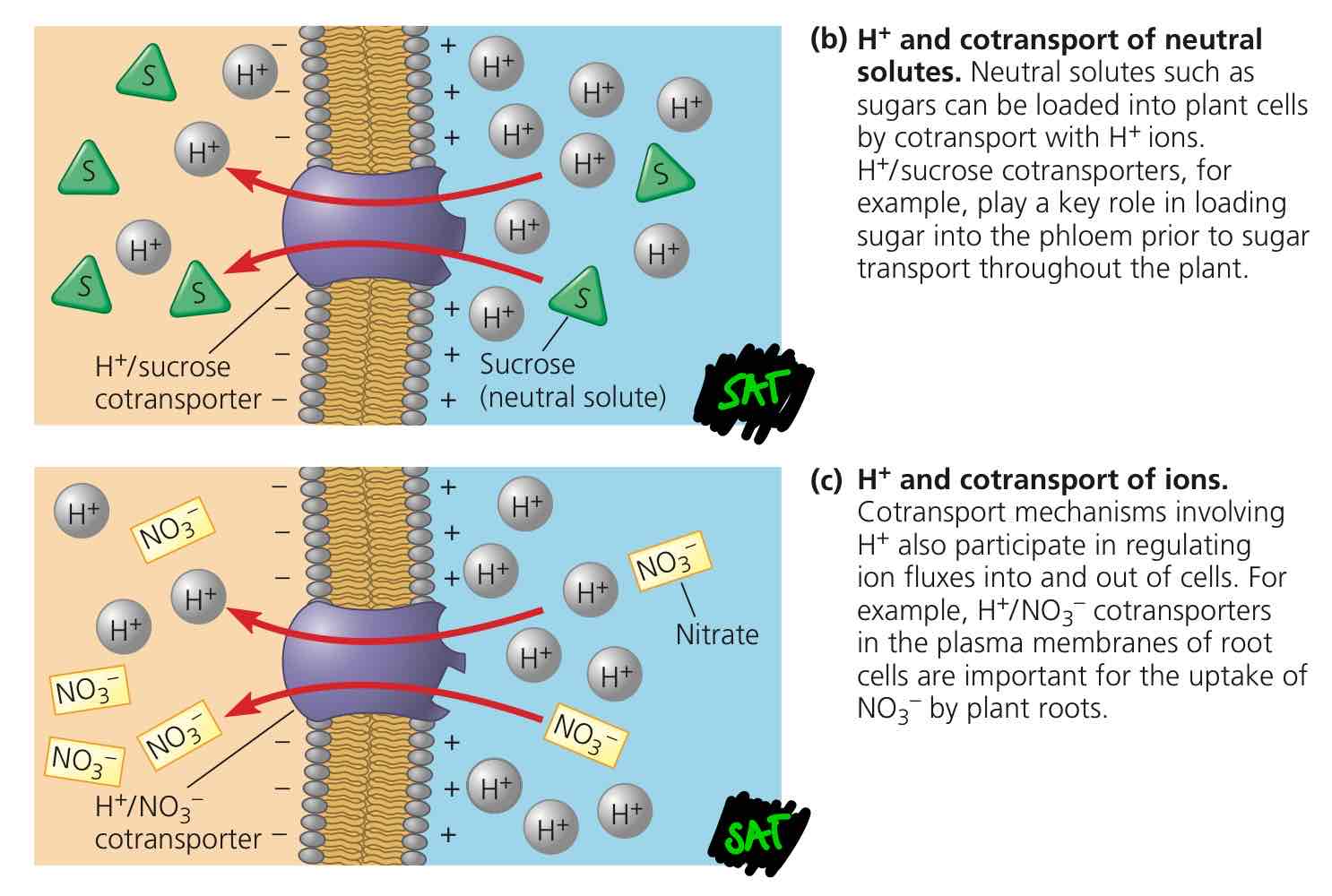
What happens in the mechanism involving gated potassium channels (GPC mechanism)?
In the GPC mechanism, the ion channels open and close in response to voltage, stretching of the membrane, and chemical factors, allowing specific ions to diffuse across the membranes.

What is a hypertonic solution?
A solution with more solutes than the cell, with water rushing out of the cell.
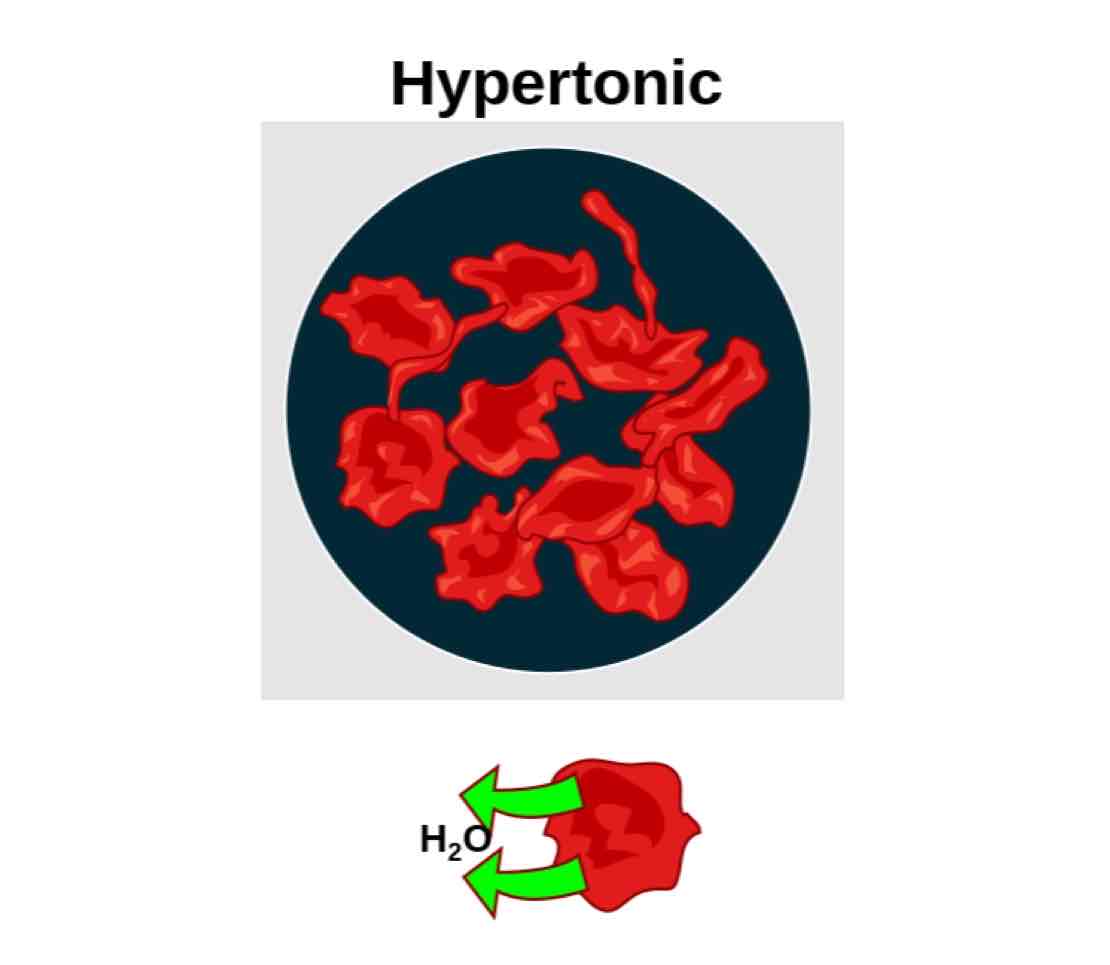
What is a hypotonic solution?
A solution with less solutes than the cell, with water rushing into the cell.
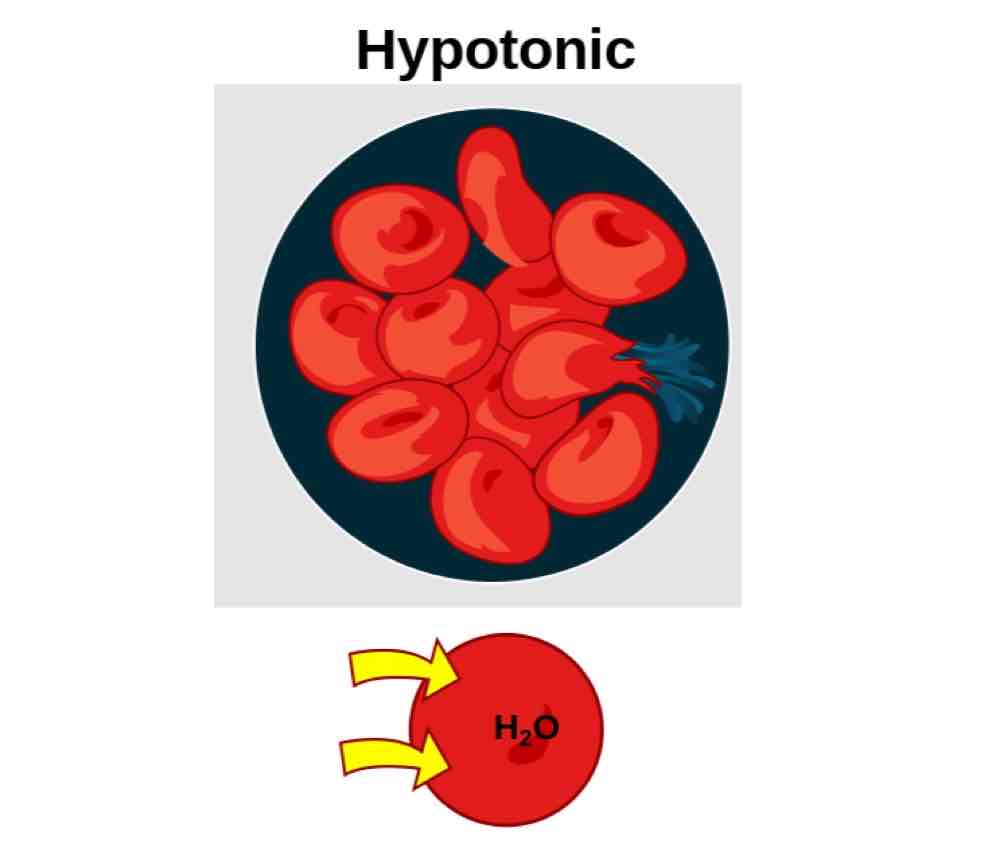
What is an isotonic solution?
A solution with the same amount of solutes with the cell, with no net movement of water between solution and cell.
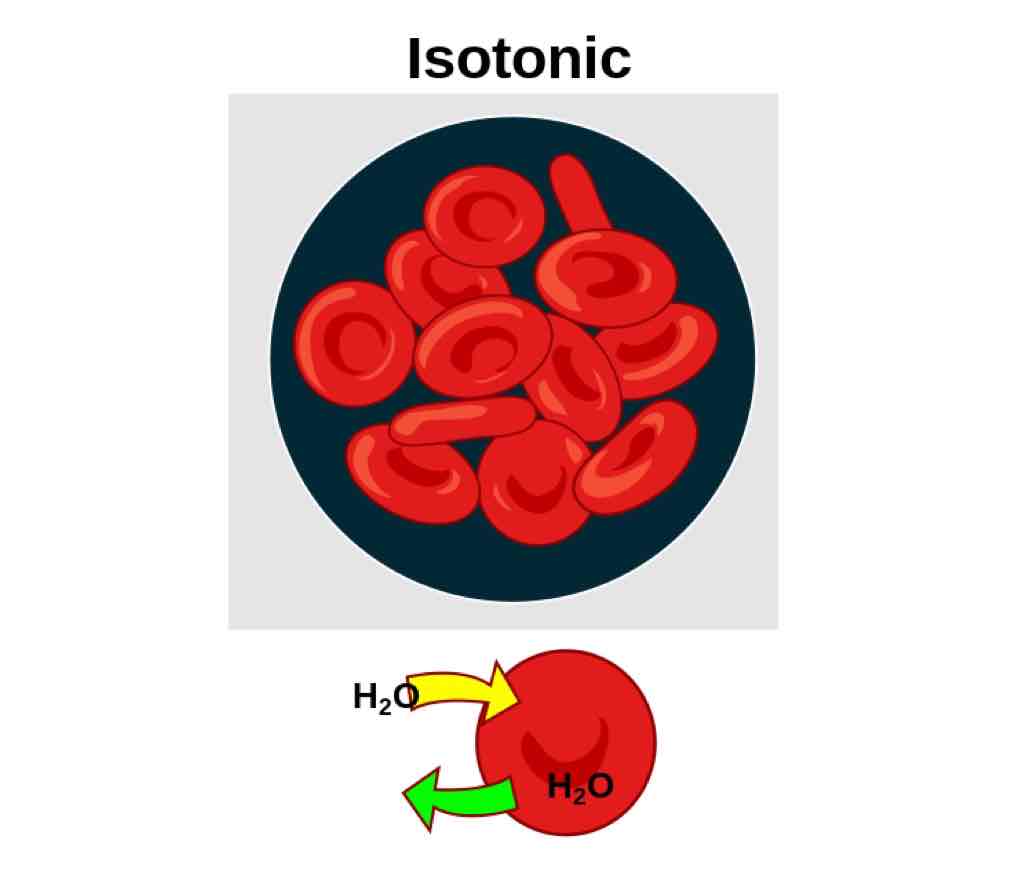
What is the water potential of pure water?
Zero.
Would water potential decrease or increase in response to the presence of solutes? How about if pressure was present?
Water potential decreases in presence of solutes, and can increase or decrease in presence of pressure, depending on whether it’s positive or negative pressure.
What’s positive pressure?
Think of blowing into a straw in your cup of water. You’re applying pressure to the system - your water. This is positive pressure, increasing water potential.

What’s negative pressure?
Think of sucking out of a straw from your cup of water. You’re removing pressure from the system - your water. This is negative pressure, decreasing water potential.
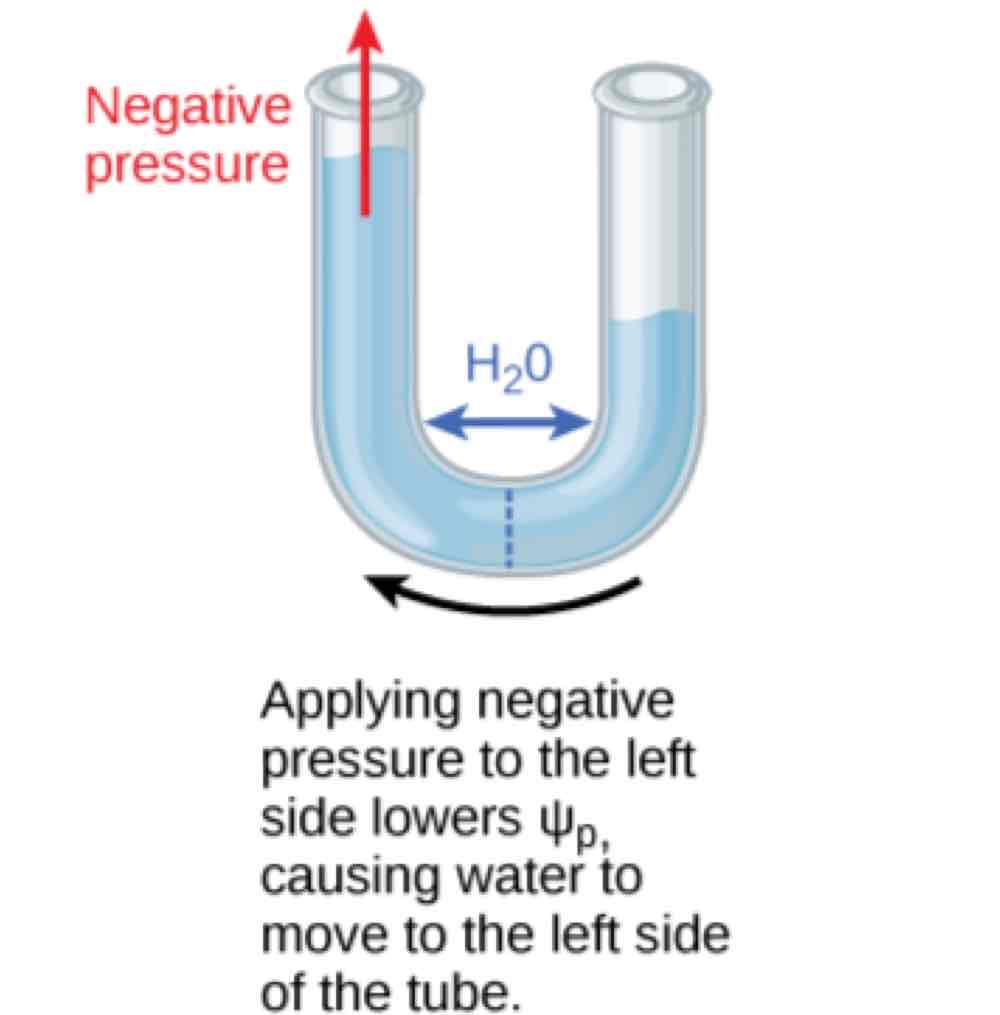
Why would the potential of water decrease when solutes are present?
Think of the water as something that has the potential to do work. Once solutes are present, free water molecules will bind to solutes. It does work. It spends some of its potential. Hence, that is why water potential decreases when solutes are present.
Where will water flow, in regards to water potential?
From high water potential to low water potential.
What is turgor pressure?
The ocurrence when water is rushing out of the cell, ultimately stretching, but not breaking, the cell wall.
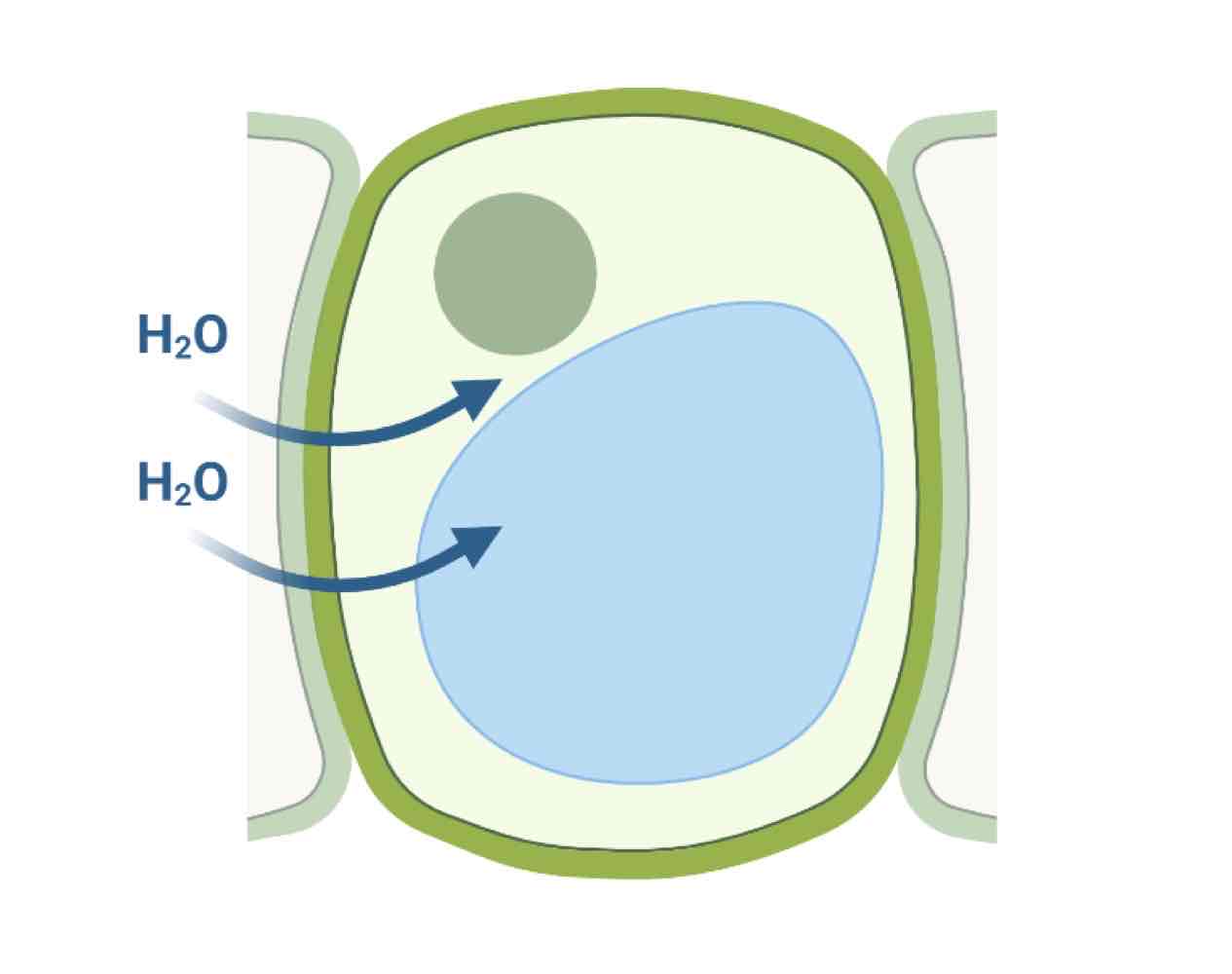
When turgor pressure within the plant is low, what will the plant look like? On the other hand, if the turgor pressure within the plant is high, what will the plant look like?
Wilted if low turgor pressure, turgid when high turgor pressure.
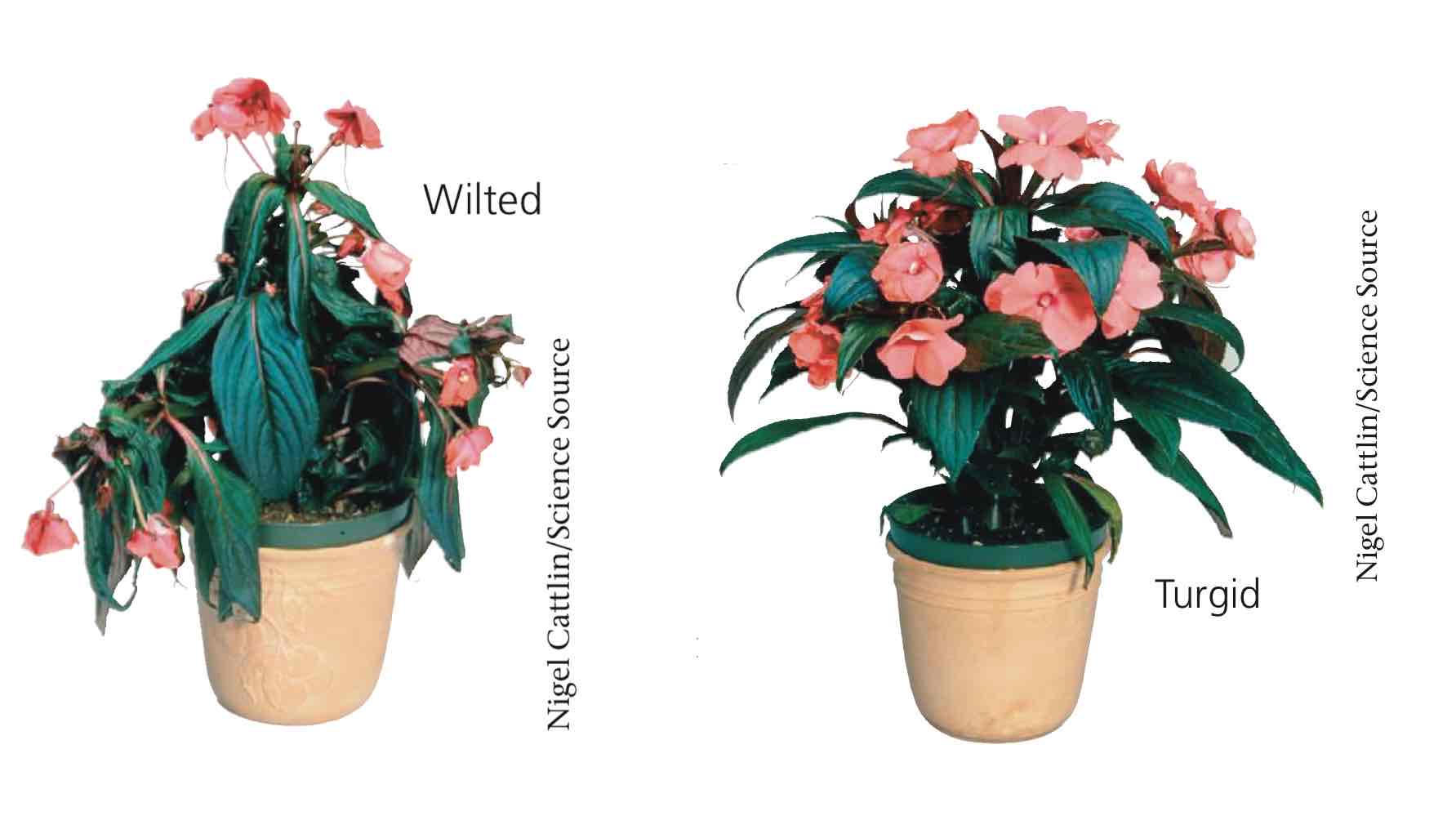
What’s the tonicity of the environment when plants are turgid? How about if it was wilted?
If turgid, hypotonic. If wilted, hypertonic.
With regards to turgor pressure, what is the “mechanism” by which stoma open?
Stoma opens when the guard cells gain K+ from neighbouring epidermal cells, making them have more solutes than the environment. If the guard cells have more solute than the environment, water rushes in (hypertonicity), opening the stoma.
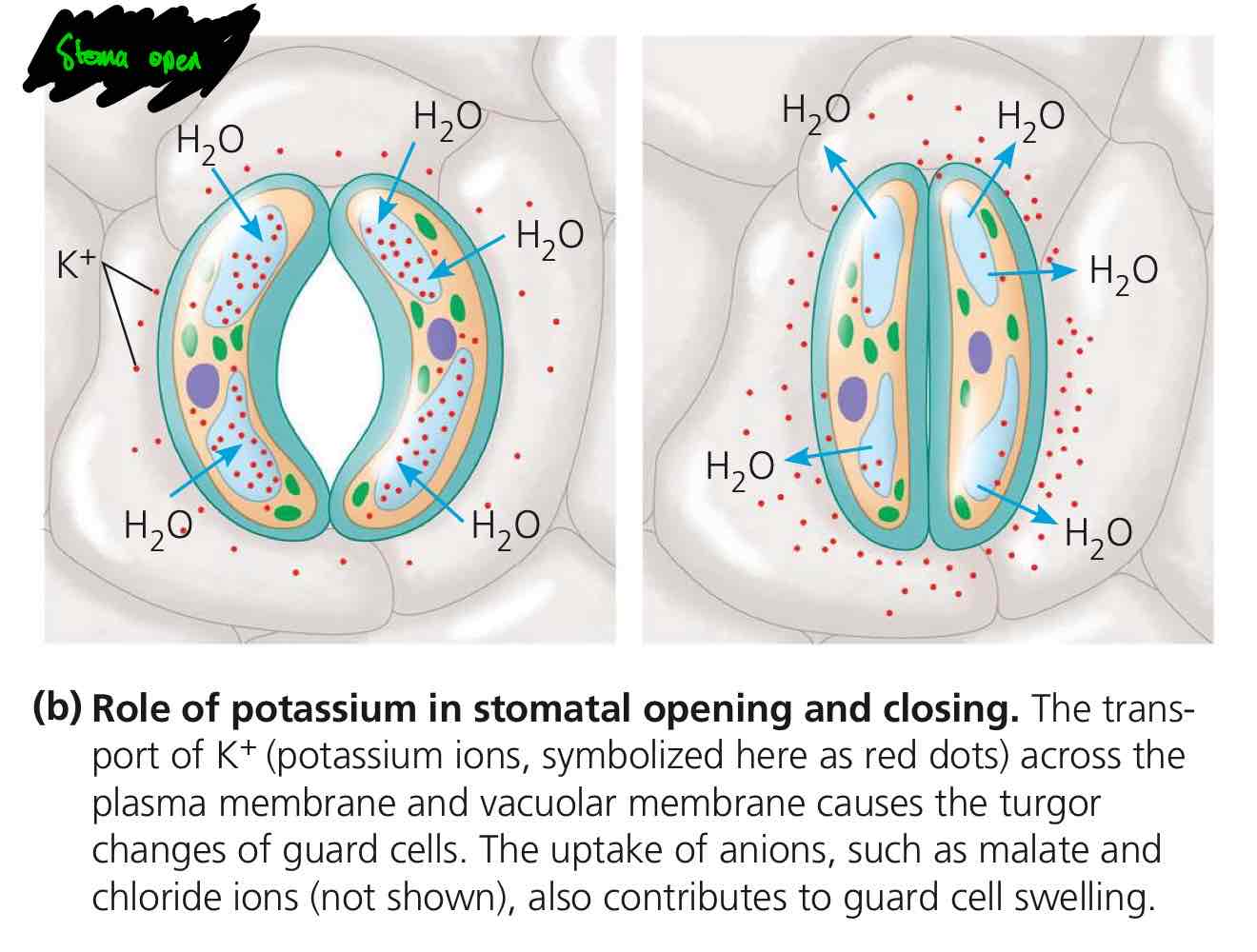
With regards to turgor pressure, what is the “mechanism” by which stoma close?
Stoma closes when the guard cells lose K+ to neighbouring epidermal cells, lessening the amount of solutes that they have. The environment has now more solute than within the cell. Water rushes out (hypotonicity), closing the stoma.
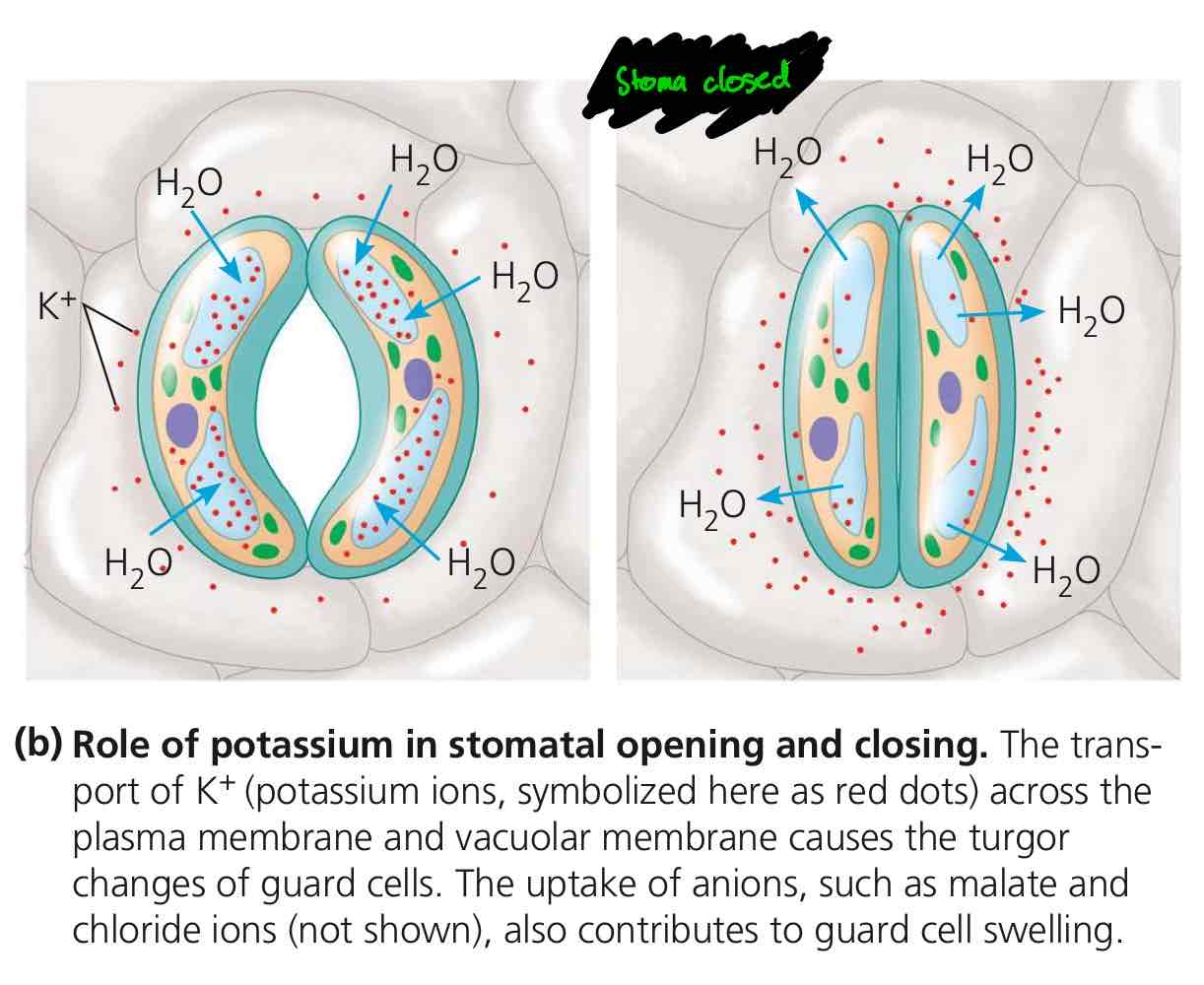
What is bulk flow?
The movement of any fluid due to positive pressure or negative pressure, occurring in long-dstance transport.
What is the Caspian strip, and what is its function?
Hydrophobic barrier made of waxy material suberin, blocking water and its solutes from entering the stele.
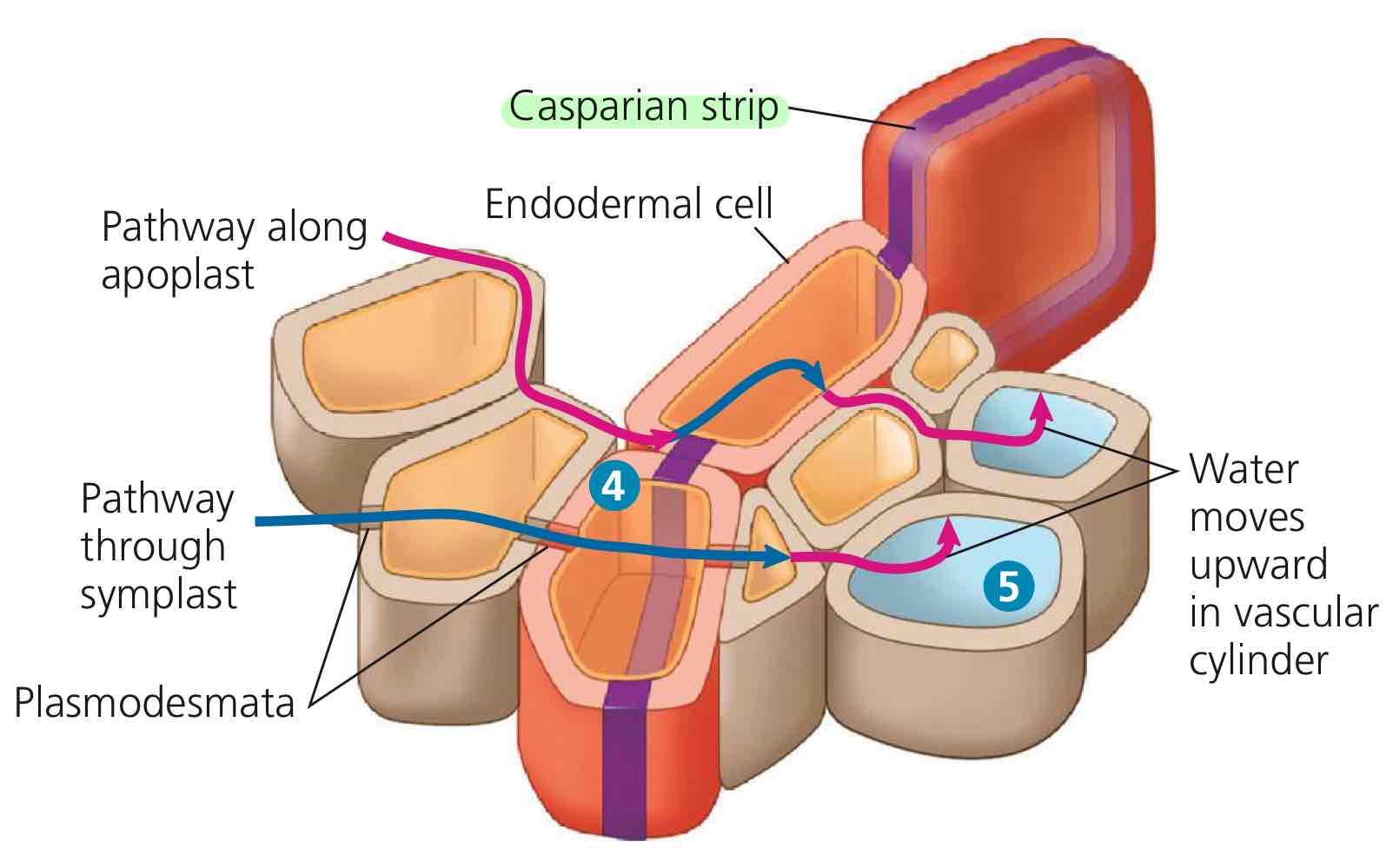
How does water and mineral (WAM) transport occur at the root hair to stele via the apoplastic route?
WAMs enter the cell wall, of the root hair, going from cell wall to cell wall (apoplastic route).
WAMs stop at the endodermis due to the Casparian strip.
WAMs are forced to switch to the symplastic route. Once they get through the endodermal cell via the symplastic route, they switch to apoplastic route to go through the endodermis cell wall.
WAMs then get through stele cell walls to get to the xylem cell wall, entering vascular tissue system from there.

How does water and mineral transport occur at the root hair to stele via the symplastic route?
WAMs enter the root hair cell wall, passes through the root hair cell membrane, then passes through multiple cells through plasmodesmata.
WAMs arrive at the endodermis, where they can continue to go through the plasmodesmata of the endodermal cells and stele cells.
WAMs then switch to apoplastic route to get through stele cells walls to get to xylem cell wall, entering vascular tissue system from there.

In WAM transport via either apoplastic and symplastic routes, what processes occur in the switch from symplast to apoplast?
Diffusion and active transport.
What process happens once WAM enters the xylem?
Bulk flow.
There are two mechanisms present in plants that have the goal of displacing xylem sap upward. What are these two mechanisms?
Root pressure and cohesion-tension mechanism.
In simple words, what is root pressure?
A “push” of xylem sap.
Explain the process of root pressure.
Stomata closes.
Transpiration stops (usually occurring at night).
Endodermis actively transports solutes into the stele.
Water follows due to accumulation of negative water potential in stele.

Why is root pressure called a “push” of xylem sap?
Positive pressure.
Which plants use root pressure mostly, and why?
Small herbaceous plants. If you had a long tree, will gravity be defeated by active transport? Not really.
In simple words, what is the cohesion-tension mechanism?
The “pull” of xylem sap.
What’s cohesion?
Hydrogen bonding between water molecules.
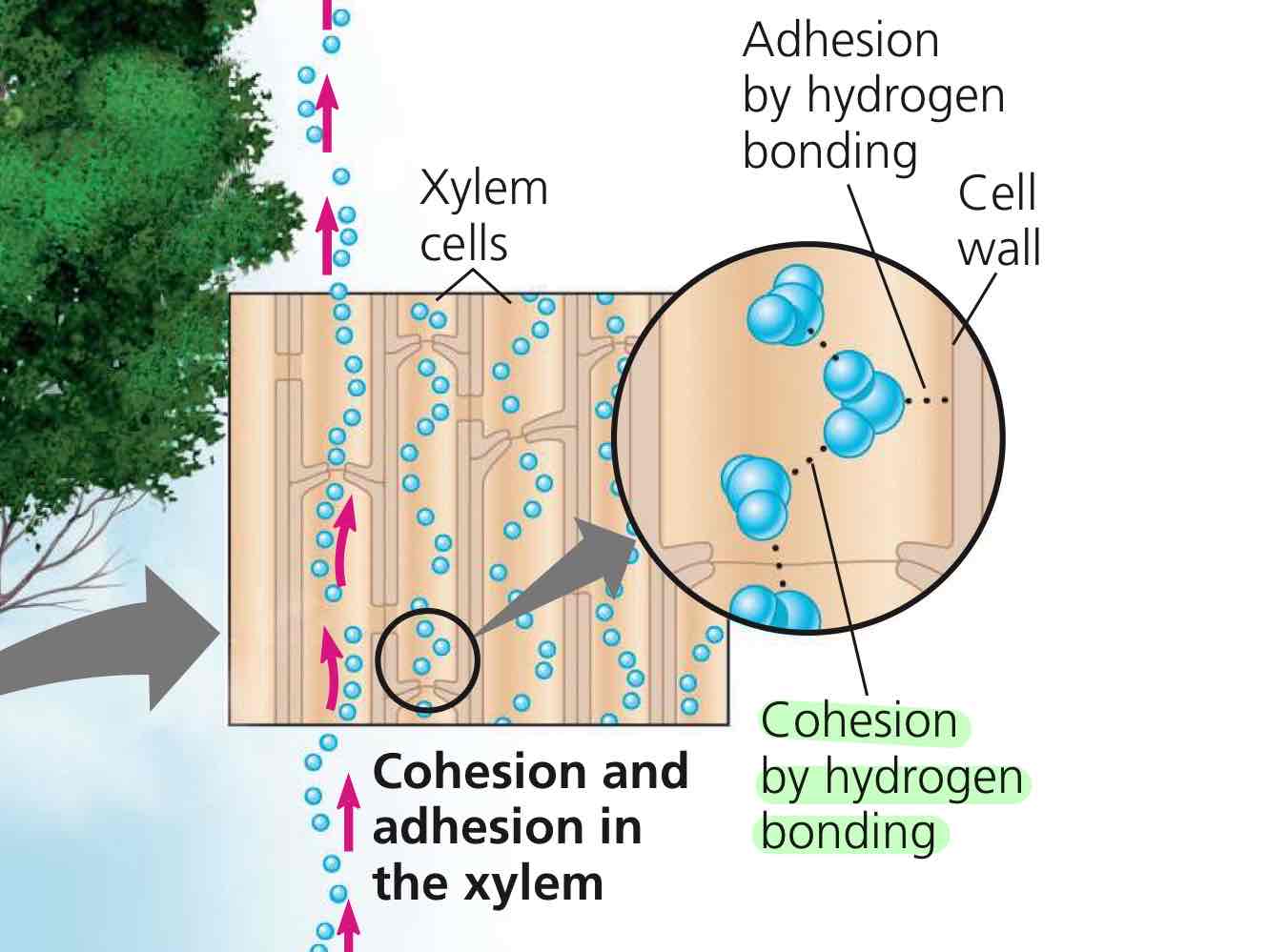
What’s adhesion?
Hydrogen bonding between water and cell wall.
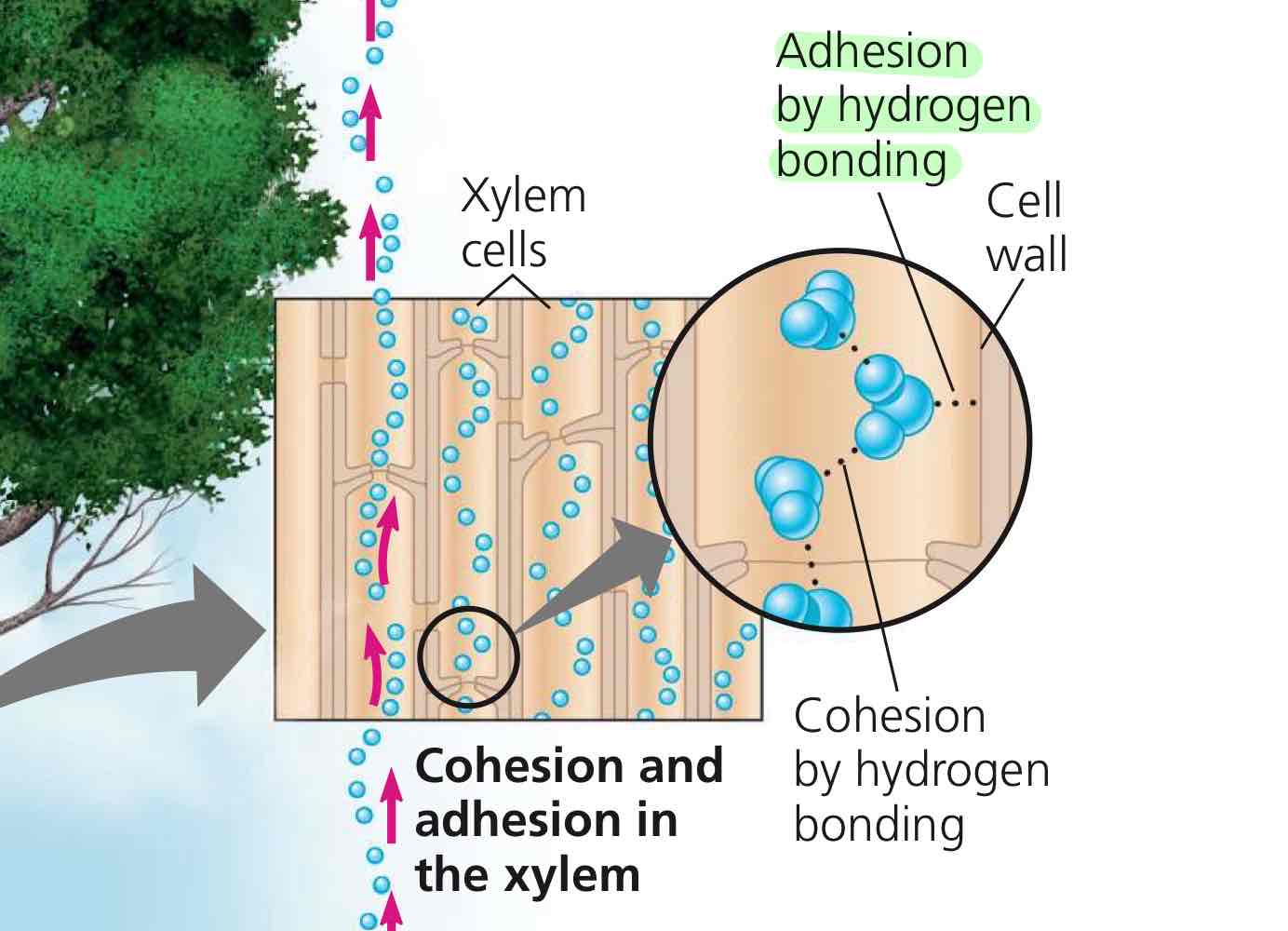
Explain the cohesion-tension mechanism.
Stomata open.
Transpiration occurs.
Constant negative pressure occurs, as the water loss on the leaves. This is constant because of cohesion and adhesion - the string of secure water molecules (secured via holding onto each other and the cell wall) are being pulled in an “orderly” fashion.

In regards to water potential, why does water move upward via negative pressure?
It all starts with the air outside of the leaf, which has a water potential of -100MPa (due to the driness and absence of pure water in the air), and the air space and the plant having a water potential above -7.0MPa. This big difference causes the water to say “Pull! Pull! Puuuuuuuuuuuuuull!”
What’s translocation?
The transport of the products of photosynthesis.
What is phloem sap?
The solution flowing through sieve tubes, consisting of photosynthates.
What is a sugar source?
Organ producing sugar by photosynthesis (leaf) or starch breakdown (root).
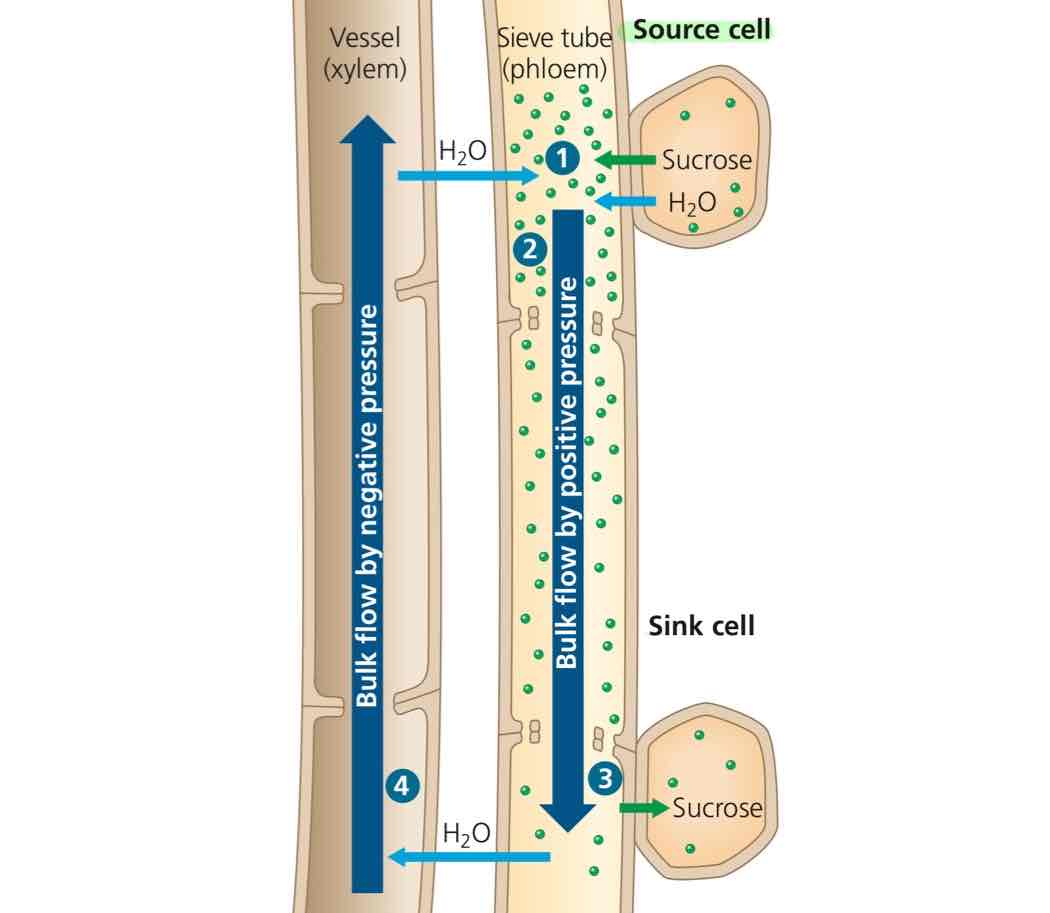
What is the sugar sink?
Organ consuming (primarily stem and leaves) or depositing sugar (root).
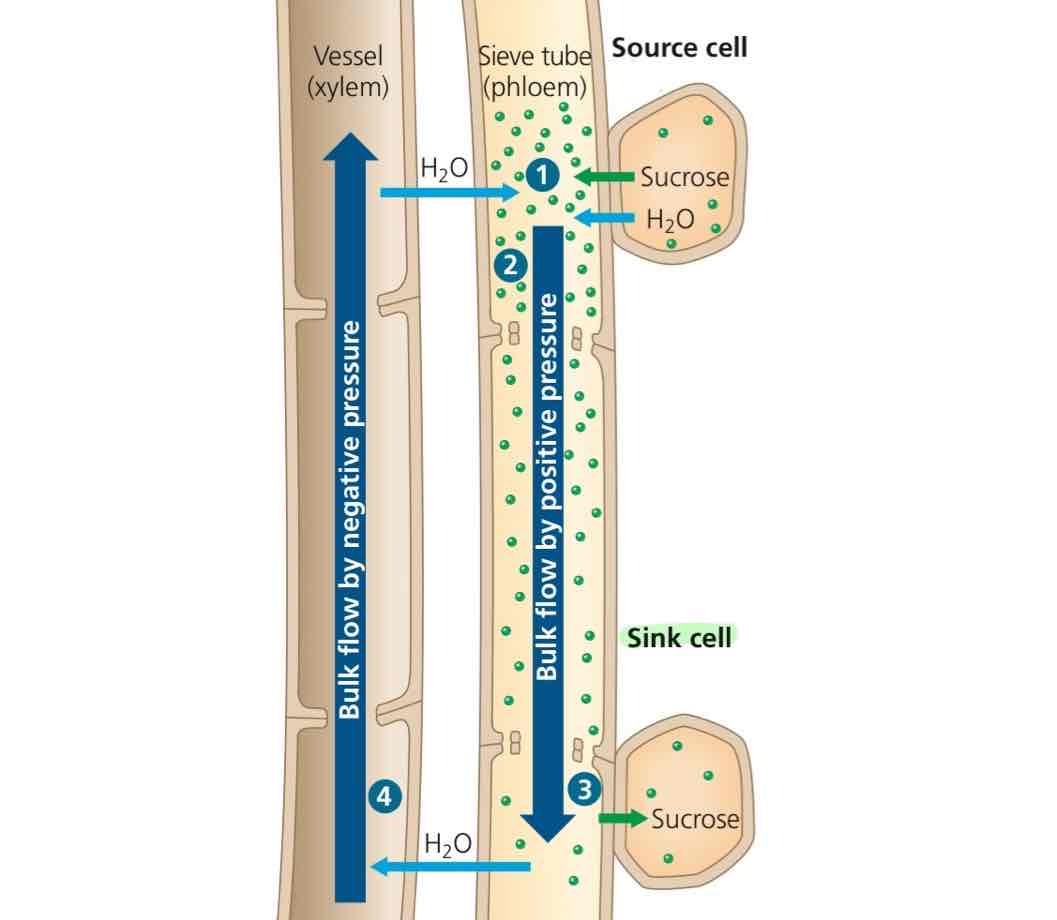
Explain phloem sap transport.
From the source cell, active transport into sieve tube. Water potential decreases in sieve tube.
Water moves out of xylem and into the sieve tube due to osmosis.
With assistance of gravity, positive pressure is applied on phloem sap and is pushed downards.
* Photosynthates are loaded into sink cells via passive and or active transport.
Xylem recycles water from phloem via negative pressure because water has to return to where there is low water potential.

Depending on the species, sugar may move by which routes? Via which route can sugar never move through? Why?
Sugar can move via (a) symplastic or (b) symplastic and apoplastic routes. Never via apoplastic alone. Would a cell want sugars moving absolutely freely? No.
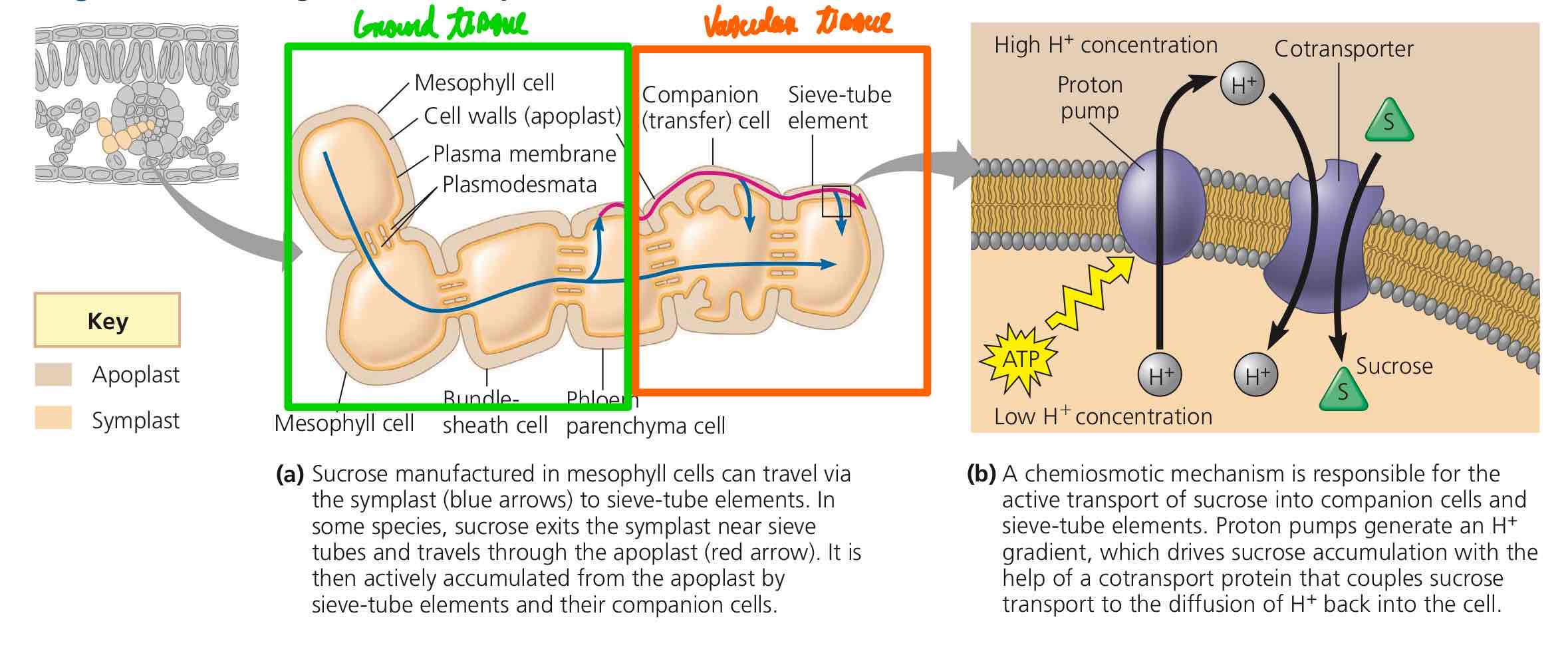
What are three adaptations for water conservation? Briefly explain each.
Minimize the leaves. If you minimize the leaves, water loss does not occur via stomata. This can happen when photosynthates are stashed first.
Recess the stoma. Making sure that the stoma doesn’t feel the dry air ensures that the stomata won’t undergo transpiration.
Reflecting the sunlight. Instead of absorbing sunlight, just reflect it. You then don’t dry the plant as much.
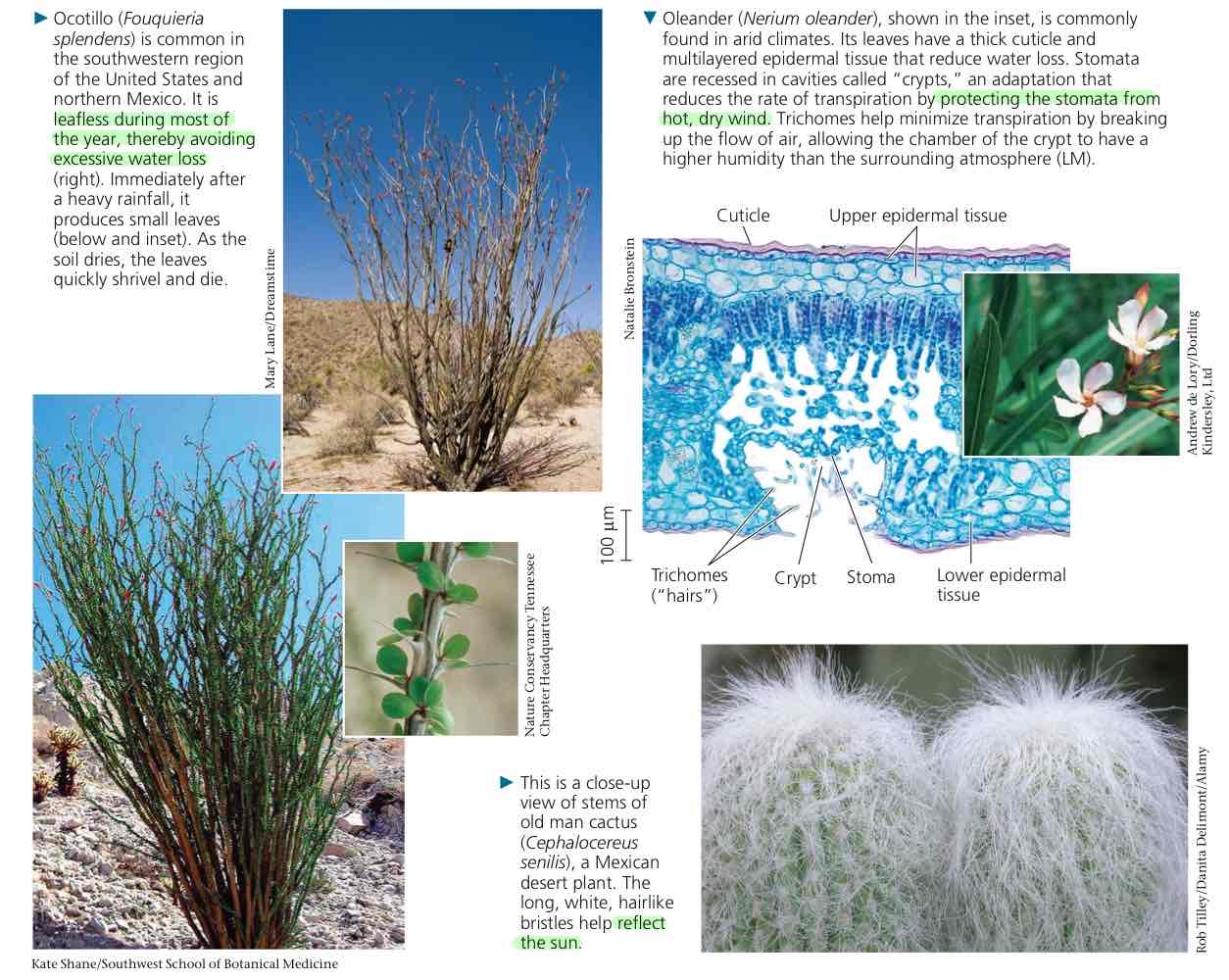
What does the root do in order to increase absorption?
Grow root hairs and lateral roots that can also grow root hairs.
A callback to plant organs - when do root hairs and lateral roots form? Specifically, when, in regards to cell production in roots, do these form?
After differentiation.

What are root hairs?
Specialized trichomes with cotransporters for charged molecules to get through the cell membrane.
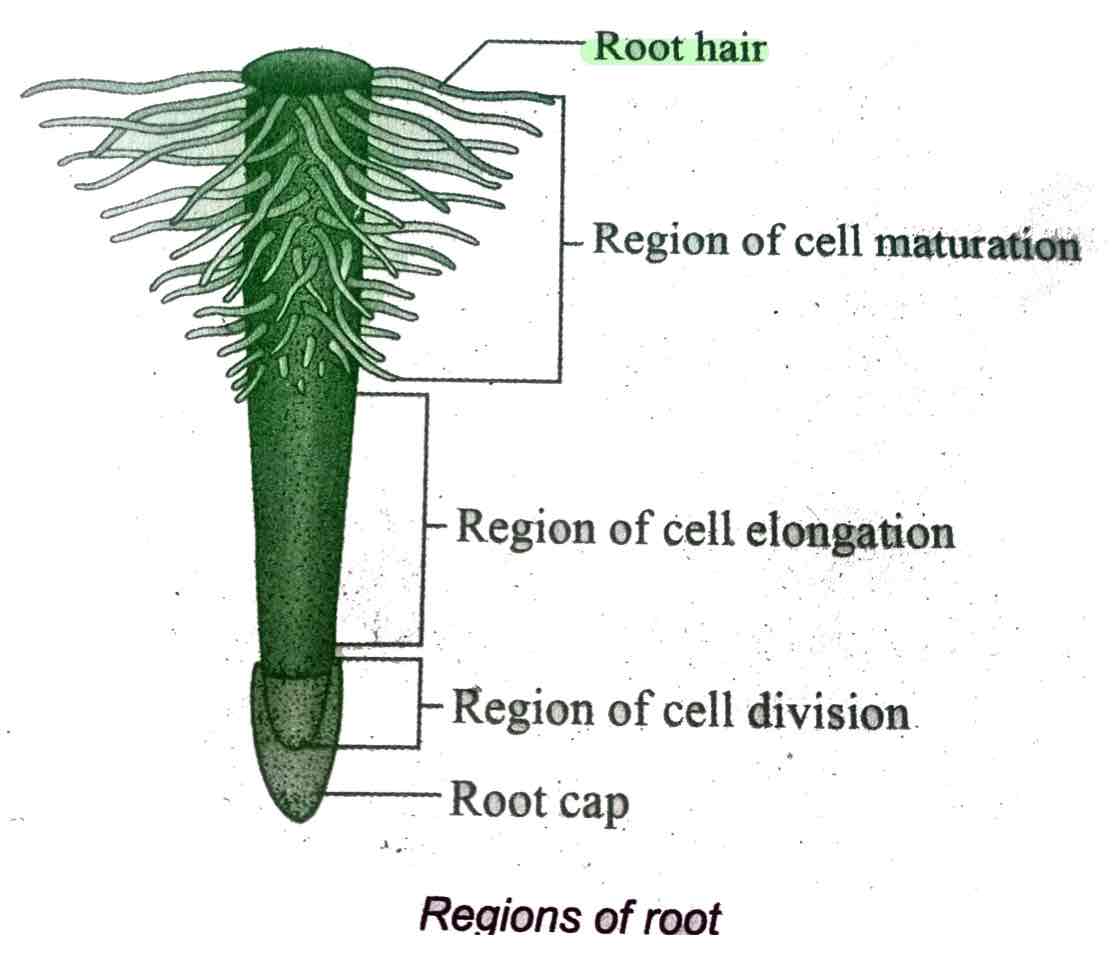
What are the two types of essential minerals in plants? What differentiates the two?
Macro essential minerals and micro essential minerals. Macro minerals are needed in large quantities, while micro is not needed in large quantities.
Explain the process of absorption.
Protons are actively transported and pumped out of the root hair into the very small spaces between a soil particle and the root hair itself.
SOIL ACIDIFICATION. The pumped protons will “sacrifice” themselves for the cationic nutrients required by the plant, taking the spot of the cations attached to the soil particles.
CATION ABSORPTION. These cationic nutrients will be absorbed by the root hair through active transport.
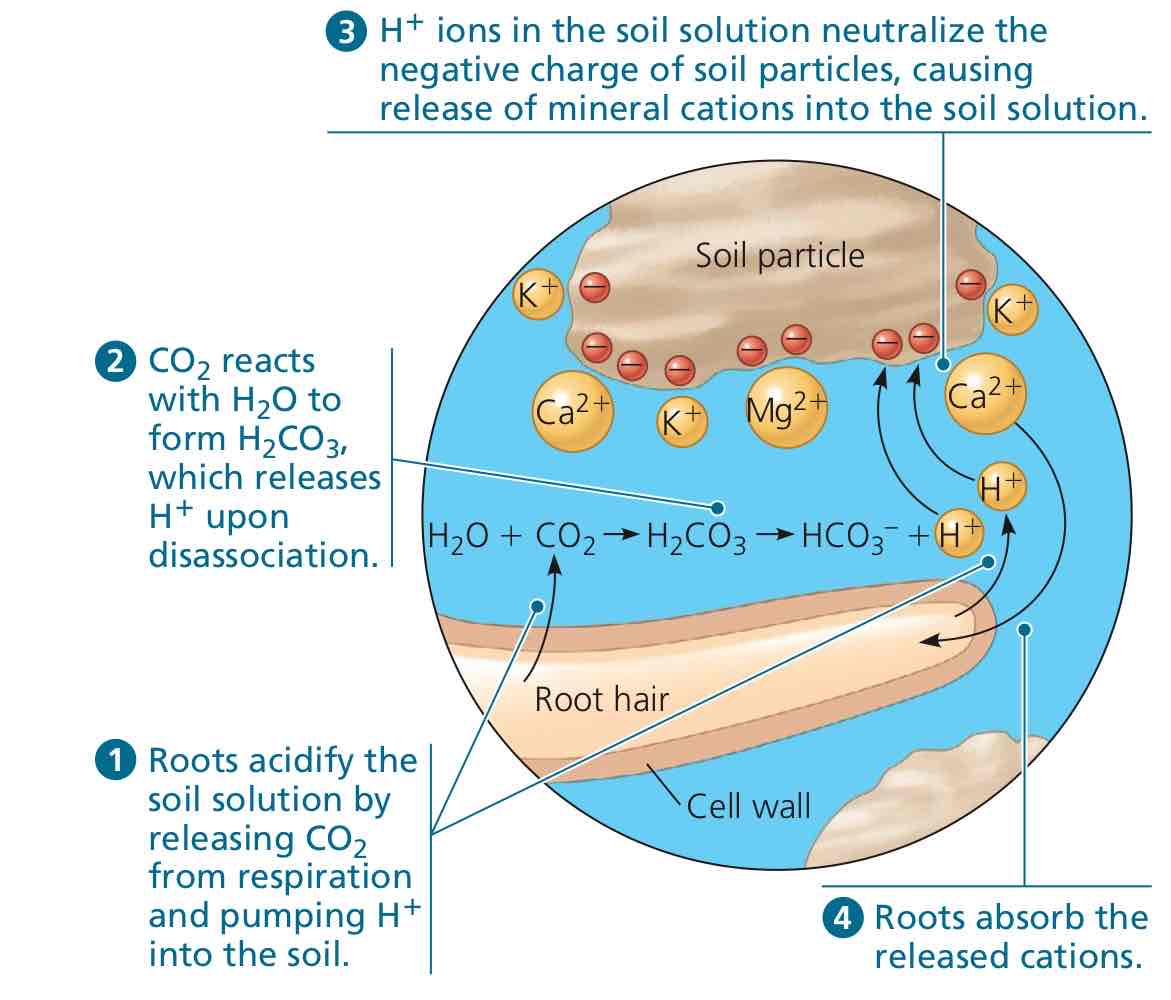
Does deficiency of a nutrient usually affect older or younger leaves?
It usually affects older leaves, nearer to RAM and farthest from SAM.
If you see a leaf that has a yellow midrib, what nutrient is it nutrient in, i.e. what specific fertilizer do you need to give it?
Deficient in nitrogen, in need of nitrogen fertilizer.
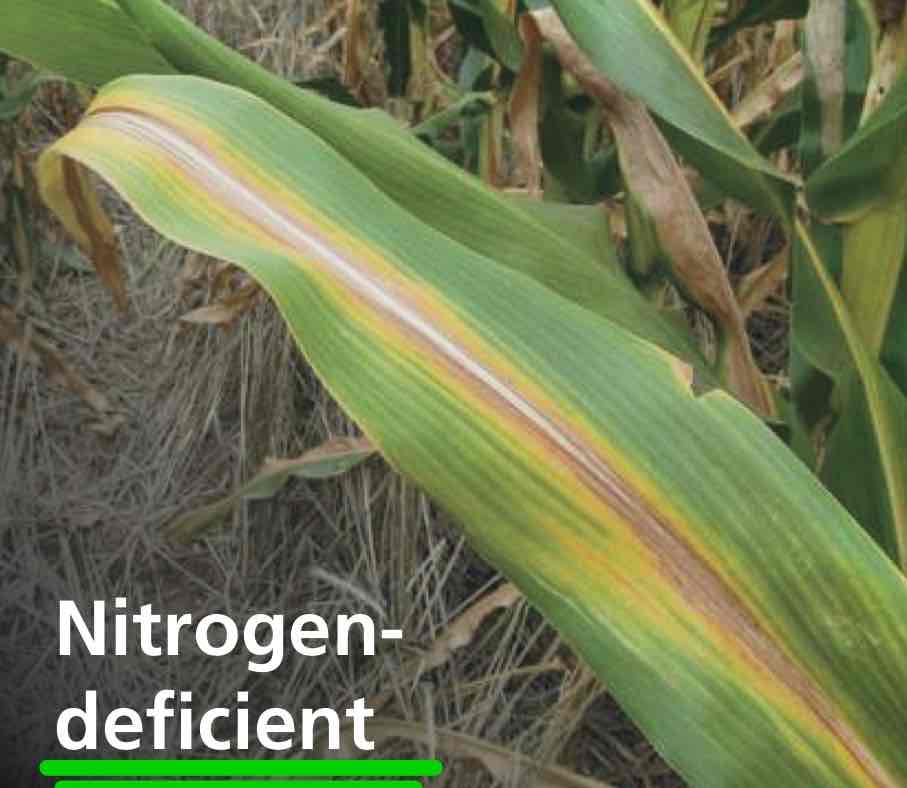
If you see a leaf that has yellow margins, what nutrient is it nutrient in, i.e. what specific fertilizer do you need to give it?
Deficient in potassium, in need of potassium fertilizer.

If you see a leaf that has reddish margins, what nutrient is it nutrient in, i.e. what specific fertilizer do you need to give it?
Deficient in phosphorus, in need of potassium fertilizer.

There are three plant adaptations for nutrient acquisition. What are these adaptations?
Epiphytes, which are plants living on plants with no root or shoot sytem, only having leaves that absorb water themselves. Proteins called aquaporins help get water in.
Parasitic plants, which are plants absorbing water, minerals, and sometimes photosynthates from other plants.
Carnivorous plants, which are plants on nitrogen-poor soils and eat insects to obtain nitrogen. Digestive enzymes break the insects’ exoskeleton before absorption.
